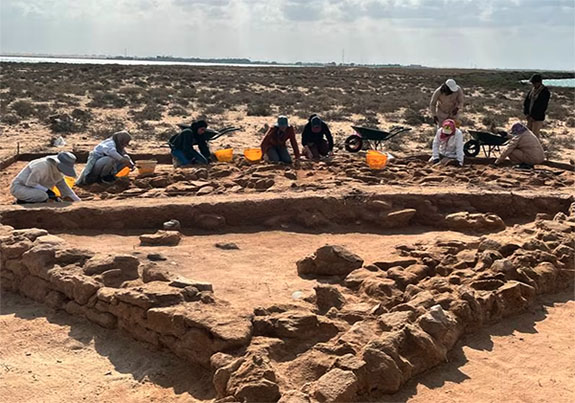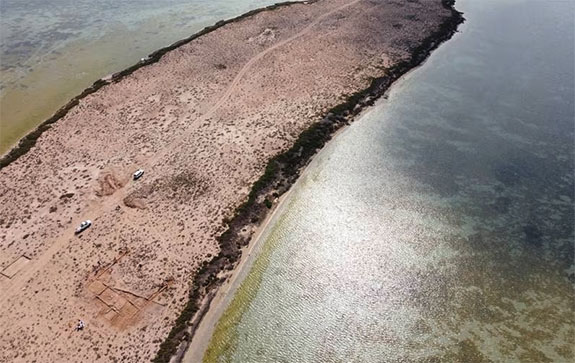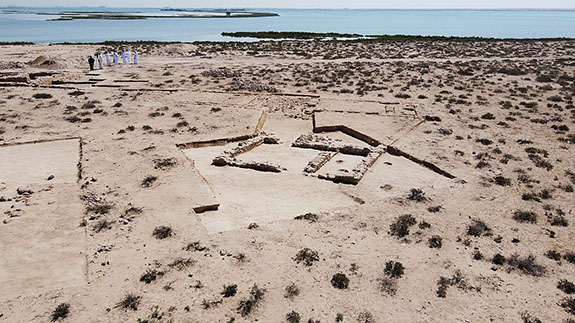March 29th, 2023
An international team of archaeologists announced last week that they unearthed the UAE’s oldest pearling village on Al Sinniyah Island, about 40 miles northeast of Dubai. The site dates back 1,300 years.

Timothy Power, an archaeologist at the United Arab Emirates University, told the AP that the ancient settlement is the oldest known example of a Khaleeji pearling town, the type of settlement that sourced and traded rare and valuable natural pearls in the Persian Gulf for thousands of years. "Khaleeji" is the Arabic word for "Gulf."
Among the items discovered at the site were pearls, pots, a diving weight and a many, many discarded oyster shells.
The diving weight is an apparatus worn by free divers to quickly descend to the seabed, where they would search for oysters while holding their breath. The diving weight recovered at the site is the oldest ever documented in the UAE.
A significant portion of the pottery found at the site was made in India, which proves the local residents were trading pearls for Indian goods.
The large mound of discarded shells is a testament to the number of oysters collected during the 200 years of production at the site.
“You only find one pearl in every 10,000 oyster shells. You have to find and discard thousands and thousands of oyster shells to find one,” Power told the AP. “The waste, the industrial waste of the pearling industry, was colossal. You’re dealing with millions, millions of oyster shells discarded.”
While pearling has been a fundamental component of this region's heritage and livelihood for more than 7,000 years, unearthing settlements like the one on Al Sinniyah Island has been an elusive challenge for archaeologists. The recent find is unique because it hadn't been resettled since pearling activity ended in the 8th century and was left virtually undisturbed.

The pearling village, which included one-room homes in close proximity to more lavish multi-level homes with courtyards, reflected the fact that poor divers and wealthy merchants were living side by side.
Spread across 12 hectares (about 30 acres), the structures were made from beach rocks, lime mortar and palms trunks that were brought over from the mainland. Powers told CNN that this was a year-round settlement, "a proper town."

The pearling community, which included hundreds of homes and thousands of people, shared the island at the time with a Sinniyah Christian Monastery. The archaeologists are still trying to noodle out why the monastery was built on a the pearling island, but surmised that the pearl divers and merchants were likely Christians. The town predates the rise of Islam across the Arabian Peninsula.
Taking part in the excavation of the pearling village were the Umm al-Quwain’s Department of Tourism and Archaeology, UAE University, the Italian Archaeological Mission in the emirate and the Institute for the Study of the Ancient World at New York University.
According to CNN, at the height of the Persian Gulf pearling industry in the 19th century, nearly two in three men living in Abu Dhabi were connected to that industry.
Credits: Photos top and middle courtesy of Umm al Quwain Tourism and Archaeology Department. Photo at bottom by Alexandermcnabb, CC BY-SA 4.0, via Wikimedia Commons.

Timothy Power, an archaeologist at the United Arab Emirates University, told the AP that the ancient settlement is the oldest known example of a Khaleeji pearling town, the type of settlement that sourced and traded rare and valuable natural pearls in the Persian Gulf for thousands of years. "Khaleeji" is the Arabic word for "Gulf."
Among the items discovered at the site were pearls, pots, a diving weight and a many, many discarded oyster shells.
The diving weight is an apparatus worn by free divers to quickly descend to the seabed, where they would search for oysters while holding their breath. The diving weight recovered at the site is the oldest ever documented in the UAE.
A significant portion of the pottery found at the site was made in India, which proves the local residents were trading pearls for Indian goods.
The large mound of discarded shells is a testament to the number of oysters collected during the 200 years of production at the site.
“You only find one pearl in every 10,000 oyster shells. You have to find and discard thousands and thousands of oyster shells to find one,” Power told the AP. “The waste, the industrial waste of the pearling industry, was colossal. You’re dealing with millions, millions of oyster shells discarded.”
While pearling has been a fundamental component of this region's heritage and livelihood for more than 7,000 years, unearthing settlements like the one on Al Sinniyah Island has been an elusive challenge for archaeologists. The recent find is unique because it hadn't been resettled since pearling activity ended in the 8th century and was left virtually undisturbed.

The pearling village, which included one-room homes in close proximity to more lavish multi-level homes with courtyards, reflected the fact that poor divers and wealthy merchants were living side by side.
Spread across 12 hectares (about 30 acres), the structures were made from beach rocks, lime mortar and palms trunks that were brought over from the mainland. Powers told CNN that this was a year-round settlement, "a proper town."

The pearling community, which included hundreds of homes and thousands of people, shared the island at the time with a Sinniyah Christian Monastery. The archaeologists are still trying to noodle out why the monastery was built on a the pearling island, but surmised that the pearl divers and merchants were likely Christians. The town predates the rise of Islam across the Arabian Peninsula.
Taking part in the excavation of the pearling village were the Umm al-Quwain’s Department of Tourism and Archaeology, UAE University, the Italian Archaeological Mission in the emirate and the Institute for the Study of the Ancient World at New York University.
According to CNN, at the height of the Persian Gulf pearling industry in the 19th century, nearly two in three men living in Abu Dhabi were connected to that industry.
Credits: Photos top and middle courtesy of Umm al Quwain Tourism and Archaeology Department. Photo at bottom by Alexandermcnabb, CC BY-SA 4.0, via Wikimedia Commons.


